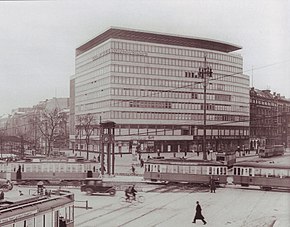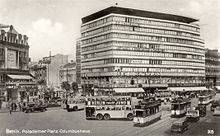Columbus House

The Columbushaus (not to be confused with the Columbiahaus ) was a nine-storey office and commercial building on Potsdamer Platz in Berlin that existed from 1932 to 1957 , which, in addition to the then modern architectural design by the architect Erich Mendelsohn, was also due to the events at the end of the war in 1945 and during the Of the June 17, 1953 uprising in which it was set on fire.
history

The Columbushaus was built from 1930 to 1932 by Erich Mendelsohn on behalf of the property owner Wertheim on the site of the Grand Hotel Bellevue , which was demolished in 1928 .
The large nine-storey building stood out clearly from the other buildings on Potsdamer Platz with its modern, horizontal facade structure. Up to now there have been buildings from the Wilhelminian era or buildings with a classical design. Thanks to a steel skeleton construction , the office floors were almost column-free and could be divided almost as desired with non-load-bearing partition walls. In the Columbushaus there was an artificial ventilation system for the first time in Germany .
Due to the complex building services and the difficult economic situation after the Great Depression , the skyscraper had difficulties in the first few years after its completion in spring 1932 in finding tenants for the offices on the second to eighth floors as well as the shops on the ground floor and first floor and was initially standing almost completely empty, despite "reasonable prices" for office space from 75 marks .
This made the Columbushaus an exception among the high-rise buildings in Berlin. A license applied for at the end of 1932 for a café and a restaurant with a roof garden on the first and ninth floors was initially not granted.
When, in December 1932, it finally came to letting a shop to the uniform price store Woolworth , a new regulation for the establishment of new uniform price stores initially prevented the opening. Despite the ban, the competent authorities were given the opportunity to allow exceptions, and since no other tenant could be found, the Minister for Economic Affairs and Labor made use of the exception and allowed Woolworth to open the branch on Potsdamer Platz. However, the Woolworth company had to undertake not to open any further branches in Prussia by April 1, 1936, thus giving up the intention to also set up branches in Friedenau ( Rheinstrasse 10) and Neukölln ( Bergstrasse 1).
From autumn 1932, COLUMBUSHAUS self- advertising was attached to the outer facade on the 9th floor , initially on both building fronts. From 1934 self-promotion on Bellevuestrasse ceased. In 1933 and 1934, doctors, lawyers, smaller branch agencies and associations were initially located in the building. In 1935 the company Büssing NAG followed , which had a large outdoor advertisement attached to the facade, and other well-known larger companies. During the 1936 Summer Olympics in Berlin, the building housed the information center for the organizing committee of the games. The German steel works were in 1937 and 1938 represented the Columbus house with office and outdoor advertising. From 1934 to 1938, a large neon advertisement supplied by Siemens-Schuckert for the National Socialist newspaper Braune Post was mounted on the roof.
On December 1, 1939, Richard von Hegener rented three or four office rooms in the house for the front organizations that had been founded to carry out the National Socialist murders, " Aktion T4 ". This central office was used at least until April 1940, when the nearby Tiergartenstrasse 4 was the headquarters of the organization. In the Berlin address book in 1941 there was an entry for the charitable Krankentransport GmbH in the Columbushaus .
During the heavy air raid on Berlin on February 3, 1945 , the Columbushaus was also hit and burned down completely. In the Battle of Berlin at the end of the Second World War , the high-rise received further damage, although the load-bearing structures were largely retained due to the modern construction.
After the war, the house was in the Soviet sector , because the property of the Columbus house and the entire Lenne Triangle in April 1938 by the Tiergarten district the district center had been assigned. Attempts to reverse this change of territory were not supported by the Allies.
In the years 1945–1948 Wertheim used the shop and office space formerly used by Woolworth and later by AWAG. After the expropriation of the Wertheim Group in East Berlin , the premises were taken over by the trade organization (HO).

At the end of 1949, individual damage to the building's load-bearing structure was repaired by replacing steel girders. In the second half of 1950, GDR engineering offices worked out design and implementation plans for the renovation of the entire building. However, only the work on the ground floor and the first floor was carried out; the upper floors were not repaired and were still recognizable by the damaged facade areas and windows. At the end of December 1950, the renovation work was largely complete and an HO department store moved into the entire ground floor and first floor. Large HO signs were placed on the roof and above the windows of the first floor, and food, meat products, vegetables, textiles and leather goods were advertised above the shop windows on the ground floor. In addition, the People's Police moved into the building with a police station. On special occasions, for example the World Youth Games in 1951 , political slogans were attached to the ribbon windows or propaganda posters were placed over larger areas of the facade.
During the uprising of June 17, 1953 , the Columbushaus was stormed and set on fire. The ruins were torn down in 1957, four years before the wall was built . The structural parts of the steel frame were dismantled and used elsewhere.
Since the Berlin Wall was built in a straight line along Friedrich-Ebert-Straße in 1961 , the fallow property belonging to the East Berlin district of Mitte was between Friedrich-Ebert-Straße and Bellevuestraße, called " Lenné-Dreieck ", in front of the wall and against it Access from West Berlin was only barely secured with a fence.
The property hit the headlines due to the planned extension of a section of the city motorway ( west bypass ) through the zoo and a protest against this occupation in 1988. The property with the Lenné triangle came to the west shortly before the political turnaround -Berlin's Tiergarten district.
After the fall of the Berlin Wall , the Beisheim Center with several hotels such as the Marriott and the Ritz-Carlton was built at the old location of the Columbushaus north of Bellevuestrasse as part of the reconstruction of Potsdamer Platz by Otto Beisheim and other investors .
literature
- Architects and Engineers Association of Berlin V. (Ed.): Industrial buildings, office buildings. (= Berlin and its buildings , part IX.) Wilhelm Ernst & Sohn, Berlin 1971, ISBN 3-433-00553-2 .
- Erich Mendelsohn : The Columbushaus in Berlin in 29 pictures . In: Wasmuthsmonthshefte für Baukunst und Städtebau , Edition XVII, year 1933, Verlag Ernst Wasmuth AG , Berlin, pp. 81-88 (unfortunately not yet digitized).
Web links
- Timeline for the history of the Columbushaus
- Columbushaus at potsdamer-platz.org
- Columbushaus, aerial photo from 1932 shortly after completion, still without Columbushaus lettering, window on the first floor still glued (note: the indication '1938' is incorrect)
- Columbushaus, photo from 1933
- Columbushaus, photo from 1946
Individual evidence
- ↑ Berlin's vacant skyscrapers . In: Vossische Zeitung , September 25, 1932, morning edition of the weekly supplement, p. 25, accessed on July 7, 2019.
- ↑ View of the property market - the city . In: Vossische Zeitung , January 1, 1933, morning edition of the weekly supplement, p. 19, accessed on July 7, 2019.
- ^ February 19, 1933: View of the property market - Woolworth at Potsdamer Platz . In: Vossische Zeitung , February 19, 1933, morning edition, weekly supplement, p. 23, accessed on July 7, 2019.
- ↑ Thomas Vormbaum (Ed.): "Euthanasia" in front of the court. The indictment of the public prosecutor at the Higher Regional Court Frankfurt / M. against Dr. Werner Heyde u. a. from May 22, 1962. (Heyde indictment) Berliner Wissenschafts-Verlag, Berlin, 2005. ISBN 3-8305-1047-0 . Pp. 134, 226.
- ^ Entry of the Gemeinnützige Krankentransport GmbH in the Berlin address book in 1941
- ↑ Introduction to the reprint of the supplement Technische Rundschau about the Columbushaus. In: Berliner Tageblatt , February 3, 1932
Coordinates: 52 ° 30 '36 " N , 13 ° 22' 34" E


